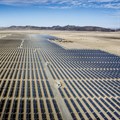
Source: Gallo/Getty
According to the International Energy Agency (IEA), in its “Renewable Energy Market Update 2022” released in May 2022, prices of raw materials and freight costs for renewable energy projects have been rising since the beginning of 2021. By March 2022, it said: “The price of PV-grade polysilicon more than quadrupled, steel increased by 50%, copper rose by 70%, aluminium doubled, and freight costs rose almost five-fold. The reversal of the long-term trend of decreasing costs is reflected in the higher prices of wind turbines and PV modules as manufacturers pass through increased equipment costs. Compared with 2020, we estimate that the overall investment costs of new utility-scale PV and onshore wind plants are from 15% to 25% higher in 2022.”
Other input costs, predominantly energy, have risen substantially because of the Russia/Ukraine war. For South African developers of renewable plants which rely on imported components, these cost increases will be magnified by the depreciation of the rand against the dollar, from R15.95/$ in January to R16.70/$ by mid-August – especially where the power purchase arrangements are dominated in local currency.
These cost increases have further compounded difficulties, initially arising from pending litigation, in closing projects bid under the Risk Mitigation Independent Power Procurement Programme (which was gazetted on 7 July 2020). Similar issues may be faced if other programmes are delayed and could apply equally where private offtaker deals suffer from their own delays.

Megan Jarvis, partner at Webber Wentzel
In this uncertain environment, where fixed pricing on long-lead items cannot always be secured, developers may be unable to sell power at the prices they bid and still make a profit. The same phenomenon affects other private sector power projects underway, such as those being developed to supply renewable energy to offtakers in the mining and other industries, where the developer has undertaken to supply power at a certain agreed price. The client in turn has budgeted for that cost and may also have limited room for cost escalations.
Building cost escalations into contracts
Many contracts may have prudently allowed for an annual escalation in tariffs of CPI plus a certain percentage or in line with a formula for certain items. However, although CPI may be a measure of the shifting costs of the CPI basket of goods, the composition of capital costs in renewable energy projects is not reflected by this basket. CPI is also not an immediate measure of international commodity fluctuations, so CPI-linked cost escalations will deliver little comfort if project development timeframes are more limited than the realised effect on the basket.
Even though buyers of power may be sympathetic to these cost pressures (since they are being felt broadly across many industries), a buyer cannot be expected to give a developer a blank cheque. On the other hand, a developer would be hard pressed to continue with an uneconomic project and it is not in the client’s interest if the developer of the project goes into business rescue and work is suspended indefinitely – which has happened on more than one renewable project. Similarly, suppliers and original equipment manufacturers, whose costing is more directly affected by these fluctuating input costs, cannot necessarily absorb this risk and certainly cannot do so indefinitely without being pushed into uneconomic arrangements.

Tyron Theessen, partner at Webber Wentzel
To take some of the guesswork out of making provision for these uncertain costs, pre-emptive clauses can be built into contracts that are currently being negotiated. These include clauses allowing cost price adjustments that are based on industry-specific formulae. Invariably, a level of risk will have to be assumed by the buyer in agreeing to flexible pricing, but this may be mitigated by allowing for re-pricing of components at specified thresholds, termination for convenience provisions and other commercial arrangements where this risk is shared and managed.
When a contract is already in place, the developer and client would need to consider the terms and may need to discuss and, possibly, renegotiate terms to ensure a viable project. This may not be possible and such discussions may not go well but, in the absence of a commercial compromise, there is a real risk of the developer repudiating the uneconomic arrangement or being run into insolvency. The same considerations will apply between the developer and its contractors and further down the procurement chain.
Affected parties may also find some relief in taking out forward cover, but this may only be available on certain items, such as steel.
The key is to conclude a commercial arrangement that is fair to all parties. It needs to balance the interests of all project participants and adequately manage the risk. In this environment, some flexibility must be considered, as fixed positions will invariably lead to at least one party being compromised and likely litigation.















































